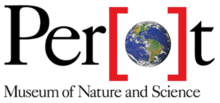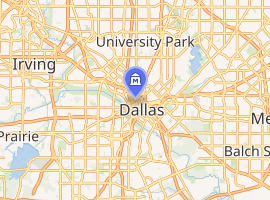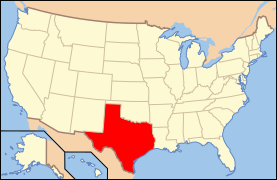Perot Museum of Nature and Science
The Perot Museum of Nature and Science (shortened to Perot Museum) is a natural history and science museum located in Dallas, Texas. It consists of two campuses: the primary campus located in Victory Park, and a secondary campus in Fair Park. The Victory Park campus museum was named in honor of Margot and Ross Perot.[3] The current chief executive officer of the museum is Dr. Linda Abraham-Silver.[2]
 | |

| |
| Established | 2006 |
|---|---|
| Location | Dallas, Texas, United States |
| Coordinates | 32.78689°N 96.80665°W |
| Type | Science museum, natural history museum |
| Visitors | 1,000,000+ [1] |
| CEO | Dr. Linda Abraham-Silver[2] |
| Public transit access | DART at Victory station |
| Website | perotmuseum.org/ |
Background

History
- June 6, 1936 – Dallas Museum of Natural History was opened to the public as part of the 1936 Texas Centennial Exhibition.
- September 20, 1946 – Dallas Health Museum was founded by a group chartered as the Dallas Academy of Medicine. The Dallas Health Museum was renamed as the Dallas Health and Science Museum in 1958. It was later renamed to the Science Place in 1981.
- 1995 – Dallas Children's Museum was founded.
In 2006, museum CEO Nicole Small oversaw the uniting of the Dallas Museum of Natural History and the Science Place and the Dallas Children's Museum at Fair Park. Following the merger, the museum was located in three buildings in Fair Park, featuring an IMAX-style theater, a fully functioning planetarium, an extensive exhibit hall, and its own on-site paleontology lab.[4][5]
On June 1, 2014 the Perot Museum of Nature and Science welcomed a new CEO, Colleen Walker.[6]
The museum relocated on December 1, 2012 to a new facility in Victory Park. The former Science Place Building and Planetarium were closed, with the building for the former Dallas Museum of Natural History converted into a second campus for the Perot Museum.[7]
Donation and Endowment
The Victory Park campus museum was named in honor of Margot and Ross Perot as the result of a $50-million gift made by their adult children — Ross Perot, Jr.; Nancy Perot Mulford; Suzanne Perot McGee; Carolyn Perot Rathjen; and Katherine Perot Reeves. The $185-million fundraising goal – which provided for the site acquisition, exhibition planning and design, construction of the new building, education programs and an endowment was achieved by November 2011, more than a year before the museum's scheduled opening in December 2012. The donated funds enabled the museum to be built without incurring any debt or public funding.[5][8]
Victory Park campus
The 180,000 square feet facility has 6 floors and stands about 14 stories high. It has five floors which are accessible to the public and houses 11 permanent exhibit halls as well as 6 learning labs.[9] The top-most floor houses the museum's administration offices. The Victory Park campus opened its doors to the public on December 1, 2012. Approximately 6,000 visitors came to the museum on its first day of operation.[10]
Building design
Designed by 2005 Pritzker Architecture Prize Laureate Thom Mayne and his firm Morphosis Architects, the building was conceived as a large cube floating over a landscaped plinth (or base) and is designed to inspire awareness of science through an immersive and interactive environment. It has a stone roof which features a landscape of drought-tolerant greenery inspired by Dallas surroundings. The building's design was conceived in collaboration with Dallas-based landscape architects, Talley Associates, the plinth is landscaped with a 1-acre rolling green roof consisting of rock and native drought-resistant grasses that reflects Texas' indigenous landscape and demonstrates a living system that will evolve naturally over time.[11] By integrating architecture, nature and technology, the building's design demonstrates scientific principles and is used as a teaching tool that provides living examples of engineering, sustainability and technology at work. Building on the museum's commitment to resource conservation, the new building integrates a variety of sustainable strategies including a rainwater collection system that captures run-off water from the roof and parking lot, satisfying 74% of the museum's non-potable water needs and 100% of its irrigation needs.
The building features a 54-foot (16 m) continuous flow escalator housed within a 150-foot (46 m) glass casing that extends diagonally outside the building cube. To maximize sustainability, the building also features LED lighting, off-grid energy generation technology and solar-powered water heating. Skylights draw natural sunlight into the atrium and to the other spaces.[8][12]
The building has secured from the Green Building Initiative the highest possible 4 Green Globes. It obtained a rating of an overall 85% on the Green Globes rating scale and 100% for its design and its sustainable performance measures.[13][14] Green Globes is a nationally recognized green building guidance and assessment program in the United States. The Green Globes rigorous assessment is also the most closely aligned certification to United States federal building requirements. The Green Globes achievement is a rarity in United States building industry where only 12 out of 759 certified buildings have reached a four Globe certification. The Victory Park building was designed and built using green building practices so that it would serve as a model of sustainability.[12]
Permanent exhibit halls
| Exhibit hall | Level | Feature Highlights[9][15] |
|---|---|---|
| Moody Family Children's Museum | Lower Level |
|
| Sports | Lower Level |
|
| Discovering Life | 2 |
|
| Being Human | 2 |
|
| Texas Instruments Engineering and Innovation | 2 |
|
| The Rees-Jones Foundation Dynamic Earth | 3 |
|
| Lyda Hill Gems and Minerals | 3 |
|
| Tom Hunt Energy | 3 |
|
| T. Boone Pickens Life Then and Now | 4 | Follow the evolution of life on Earth over 4 billion years, the Beringia land bridge where people migrated from Siberia to Alaska across a land bridge that spanned the current day Bering Strait and life in prehistoric Alaska. Soundscape for this exhibit was designed by students from the University of Texas at Dallas.[21]
|
| Expanding Universe | 4 |
|
| Rose Hall of Birds | 4 Mezzanine |
|
Temporary exhibit halls
| Exhibit hall | Level | Exhibit Name | Date | Description |
|---|---|---|---|---|
| Jan and Trevor Rees-Jones Exhibition Hall | Lower Level | Building the Building | December 1, 2012 – May 12, 2013 | Showcases the stories of the more than 2,500 people it took to create and design the Victory Park campus building and exhibits. Includes interviews with museum leaders, architect Thom Mayne, exhibit designers, landscape designer Coy Talley, Balfour Beatty construction team members, local educators from school districts and universities. Also includes the remnants of a Ford Model T discovered as the site was prepared for construction.[22] |
| Jan and Trevor Rees-Jones Exhibition Hall | Lower Level | Recycle Reef | June 17, 2013 – August 25, 2013 | Visitors will participate in building the exhibit from the ground up by using recyclable materials to transform them into creative works of art. The exhibit will be dynamic and ever-changing as it develops with each newly contributed art work. The entire exhibit will be recycled after the exhibit closes. |
| Jan and Trevor Rees-Jones Exhibition Hall | Lower Level | Animal Inside Out | September 22, 2013 – February 23, 2014 | |
| Jan and Trevor Rees-Jones Exhibition Hall | Lower Level | Build It! Garage | June 21, 2014 – August 17, 2014 | |
| Jan and Trevor Rees-Jones Exhibition Hall | Lower Level | World's Largest Dinosaur | April 6, 2014 – September 1, 2014 | |
| Jan and Trevor Rees-Jones Exhibition Hall | Lower Level | 2theXtreme: MathAlive! | September 27, 2014 – January 1, 2015 | |
| Jan and Trevor Rees-Jones Exhibition Hall | Lower Level | The International Exhibition of Sherlock Holmes | February 14, 2015 – May 10, 2015 | |
| Jan and Trevor Rees-Jones Exhibition Hall | Lower Level | Build It! Nature | June 19, 2015 – August 6, 2015 | |
| Jan and Trevor Rees-Jones Exhibition Hall | Lower Level | Amazing Animals: Built to Survive | June 13, 2015 – September 7, 2015 | |
| Jan and Trevor Rees-Jones Exhibition Hall | Lower Level | Creatures of Light: Nature's Bioluminescence | October 31, 2015 – February 21, 2016 | |
| Jan and Trevor Rees-Jones Exhibition Hall | Lower Level | Eye of the Collector | April 16, 2016 – September 5, 2016 | Nine exhibits displaying historical and fashionable objects of 10 people displaying their recollections of items they have gathered during their lives.[23] |
| Jan and Trevor Rees-Jones Exhibition Hall | Lower Level | Birds of Paradise | October 8, 2016 – January 8, 2017 | Exhibits display video footage, photographs, artifacts, and interactive experiences to create a science exhibition, art show, and natural history display from a comprehensive study of all 39 known species of birds-of-paradise.[24] |
| Lyda Hill Gems and Minerals | 3rd Floor | Giant Gems of the Smithsonian | September 9, 2016 – January 17, 2017 | Exhibit displays a close up view of the National Museum of Natural History's National Gem Collection.[25] |
| Jan and Trevor Rees-Jones Exhibition Hall | Lower Level | Maya: Hidden Worlds Revealed | February 11, 2017 – September 4, 2017 | Exhibit allowing guests to explore an underworld cave, excavate an ancient burial site, and encounter the richness of Maya culture through hands-on explorations such as building arches, deciphering hieroglyphs and translating the Maya calendar.[26] |
The Hoglund Foundation Theater A National Geographic Experience
The 297-seat Americans with Disabilities Act (ADA) compliant theater has a 2D, 3D 4K digital projection and sound system. The theater features a variety of films from educational features and documentaries to experimental independent films.[27]
Fair Park campus
Museum of Natural History | |
Texas State Antiquities Landmark | |
.jpg) Natural History Museum building in 2016 | |
 Museum of Natural History  Museum of Natural History | |
| Location | 3535 Grand Ave., Dallas, Texas |
|---|---|
| Coordinates | 32°46′42″N 96°45′47″W |
| Built | 1936 |
| Architect | Mark Lemmon, Clyde Griesenbeck |
| Architectural style | Moderne |
| Part of | Texas Centennial Exposition Buildings (1936-1937) (ID86003488[28]) |
| TSAL No. | 8200002124 |
| DLMKHD No. | H/33 (Fair Park) |
| Significant dates | |
| Designated CP | September 24, 1986 |
| Designated TSAL | January 1, 1984 |
| Designated DLMKHD | March 4, 1987[29] |
The museum at Fair Park is located in the Museum of Natural History building constructed, along with much of Fair Park, for the 1936-1937 Texas Centennial Exposition whose facilities form a historic district on the National Register of Historic Places. The campus features exhibits such as Mineral Majesty, Light Play and historical dioramas. Admission to the former Dallas Museum of Natural History is $1 for non-members and free for members. A ticket to the Perot Museum in Victory Park provides free access to the Fair Park campus.[30]
Educational outreach
The museum creates a Teacher's Guide, which is a booklet and online publication that is distributed to North Texas educators. The guide outlines programming designed for children pre-K to 12th grade in earth and space sciences, life and natural sciences, chemistry, physical sciences and engineering. Programming is designed to reinforce Texas Essential Knowledge and Skills (TEKS) objectives.[31][32]
There are three educational outreach opportunities: field trips to the museum, onsite programming at schools (in the classroom and after school), and ScienceCast distance-learning programs through videoconferencing.
Field trips
Students can explore 11 permanent exhibit halls, experience educational films in their theater, and take advantage of TEKS-aligned onsite classroom or auditorium programming. Further learning, available through program extensions, is held in the learning labs and auditorium of the museum's Lower Level. The museum also features educational films, offered in partnership with National Geographic.
Onsite programming at schools
Museum educators offer 26 programs that can be taught in schools’ classrooms, presented to large groups in auditoriums, or showcased as part of after-school programming.
Distance-learning video conferencing
ScienceCast distance-learning programs, which the museum created and introduced in 2012 to widespread acclaim, use computer technology to stream live instruction directly to the classroom, allowing students to interact with educators in real time.
See also
References
- Le, Tiffany (July 12, 2013). "Perot Museum attracts its one millionth visitor". The Dallas Morning News.
- "Perot Museum appoints Dr. Linda Abraham-Silver as the Eugene McDermott Chief Executive Officer" (Press release). Perot Museum of Nature and Science. March 2, 2017.
- Stengle, Jamie (November 17, 2012). "New Dallas science museum named for Ross Perot". USA Today.
- Rothstein, Edward (November 30, 2012). "Bursting With Science, Some of It Unsettling". The New York Times.
- Spiegelman, Willard (February 4, 2013). "How Dallas Does Philanthropy". The Wall Street Journal.
- Abril, Danielle (May 2, 2014). "Meet the Perot Museum's new CEO, Colleen Walker". Dallas Business Journal.
- "Perot Museum of Nature and Science at Fair Park". Fair Park.
- Mariani, Anthony (April 26, 2013). "Museum Swap: The Perot is Pretty Groovy". Fort Worth Weekly.
- Pinn, Rachel Edenson (November 15, 2012). "Previewing the Perot Museum of Nature and Science, from A to Z". Dallas Observer.
- Flick, David (December 1, 2012). "Dallas' Perot Museum of Nature and Science officially opens to enthusiastic crowd". Dallas Morning News.
- "Museum of Nature & Science". Talley Associates. Archived from the original on 2012-01-06. Retrieved 2013-04-01.
- Fedele, Angela (April 30, 2013). "Perot Museum Celebrates Impressive Green Recognition". Design Build Source.
- Henson, Shane (April 24, 2013). "Perot Museum awarded rare "4 Green Globes" rating". FM Link.
- "Perot Museum Achieves Green Globes Highest Possible Ranking for Sustainable Building Design" (Press release). Market Wire. April 11, 2013.
- Kaul, Greta (November 14, 2012). "What to do at Dallas' new Perot museum: Look a dinosaur in the eye, race Felix Jones". Dallas Morning News.
- "Perot Museum's Sports Run Exhibit". 900lbs of Creative. February 25, 2013. Archived from the original on May 14, 2013.
- "Goldfields welcomes home 23kg gold nugget" (Press release). Government of Western Australia. November 5, 2011. Archived from the original on June 28, 2013. Retrieved April 30, 2013.
- van Bergeijk, Jeroen (September 1, 2010). "The third largest gold nugget in the world". vanbergeijk.com.
- Radley, Whitney (January 29, 2012). "A real rock star: 62-pound gold nugget discovered by metal detectors gets its Houston moment". Culture Map Houston. Retrieved 2013-04-30.
- "It Feels Like a Million Bucks" (Press release). Houston Museum of Natural Science. 2012.
- Whiteley, Jason (December 6, 2012). "Local students designed soundscapes at new Perot Museum". WFAA. Archived from the original on April 11, 2013. Retrieved May 1, 2013.
- "Last Chance to See Building the Building Exhibit at the Perot Museum of Nature and Science". Dallas Art News (Press release). April 30, 2013. Archived from the original on March 4, 2016. Retrieved May 1, 2013.
- "Eye of the Collector". Perot Museum of Nature and Science. 2016. Retrieved February 16, 2017.
- "Birds of Paradise". Perot Museum of Nature and Science. 2016. Retrieved February 16, 2017.
- "Giant Gems of the Smithsonian". Perot Museum of Nature and Science. 2016. Retrieved February 16, 2017.
- "Maya: Hidden Worlds Revealed". Perot Museum of Nature and Science. 2017. Retrieved February 16, 2017.
- Devries, Raine (November 2, 2012). "Perot Museum will feature state-of-the-art theater and exhibits". The Examiner. Beaumont, Texas.
- "National Register Information System". National Register of Historic Places. National Park Service. November 2, 2013.
- "Ordinance No. 27079" (PDF). City of Dallas. 2008. Retrieved August 16, 2018.
- "Perot Museum of Nature and Science at Fair Park". Perot Museum of Nature and Science. Archived from the original on 2012-10-08. Retrieved 2013-04-01.
- "TEKS-aligned programs and field trips". Perot Museum of Nature and Science. Retrieved 2013-04-01.
- Weiss, Jeffrey (November 14, 2012). "Dallas' Perot Museum designed to fit with Texas-specific public school curriculum". Dallas Morning News.
External links
| Wikimedia Commons has media related to Perot Museum of Nature and Science. |


